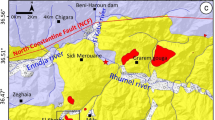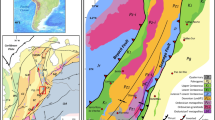Abstract
Lava dome collapses are a major threat to the population living near such volcanoes. However, it is not possible to forecast collapses reliably because the mechanisms are not clearly understood, due partly to the lack of continuous observations of such events. To address this need for field data, we have developed new monitoring stations, which are adapted to the volcanic environment. The stations tracked the complete evolution of the 2018–2019 lava dome of Merapi volcano (Indonesia) and the associated pyroclastic density currents. During the 14 months of activity, the stations acquired thermal, high-resolution visual images and movies in stereoscopic configurations. The dome developed on a plateau flanked by steep sides (~ 40°–50°) inside the crater, which was open to the SE. We observed that the dome behaved in a viscous manner (with a viscosity of 109 Pa s for the interior to 1013 Pa s for external parts of the dome) on gentle slopes, and in a brittle way (friction angle ~ 35°, cohesion < 100 kPa) on slopes steeper than 35°. Thus, the lava dome was unable to grow on the outer slopes of the plateau and a significant volume of lava (350–750 × 103 m3) accumulated and collapsed daily to the SE in relatively small volumes (< 10,000 m3), preventing the lava dome from reaching the critical volume necessary for pyroclastic density currents to form and threaten the surrounding population. The cause of the small and frequent collapses was purely gravitational during the dome activity. This suggests that relatively small differences in the summit morphology can control dome evolution, favouring either a lava dome restricted to a small volume and leading to only a minor crisis, or more voluminous dome growth and a catastrophic collapse.









Similar content being viewed by others
Change history
02 February 2021
Affiliation 4 of the paper should be: Université de Paris, Institut de physique du globe de Paris, CNRS, Paris, France (and not "Institut de Physique du Globe de Paris, CNRS, Université de Paris, Paris, France").
References
Abdurachman EK, Bourdier JL, Voight B (2000) Nuées ardentes of 22 November 1994 at Merapi volcano, Java, Indonesia. J Volcanol Geotherm Res 100(1):345–361. https://doi.org/10.1016/S0377-0273(00)00144-X
Blake S, Bruno BC (2000) Modelling the emplacement of compound lava flows. Earth Planet Sci Lett 184:181–197. https://doi.org/10.1016/S0012-821X(00)00278-8
Brodscholl A, Kirbani SB, Voight B (2000) Sequential dome-collapse nuées ardentes analyzed from broadband seismic data, Merapi Volcano, Indonesia. J Volcanol Geotherm Res 100(2000):363–369. https://doi.org/10.1016/S0377-0273(00)00145-1
Carn SA, Watts RB, Thompson G, Norton GE (2004) Anatomy of a lava dome collapse: the 20 March 2000 event at Soufriere Hills Volcano, Montserrat. J Volcanol Geotherm Res 100:241–264. https://doi.org/10.1016/S0377-0273(03)00364-0
Charbonnier SJ, Gertisser R (2008) Field observations and surface characteristics of pristine block-and-ash flow deposits from the 2006 eruption of Merapi Volcano, Java, Indonesia. J Volcanol Geotherm Res 177(4):971–982. https://doi.org/10.1016/j.jvolgeores.2008.07.008
Cordonnier B, Caricchi L, Pistone M, Castro JM, Hess KU, Gottschaller S, Manga M, Dingwell D, Burlini L (2012) The viscous-brittle transition of crystal-bearing silicic melt: direct observation of magma rupture and healing. Geology. 40:611–614. https://doi.org/10.1130/G3914.1
Cordonnier B, Lev E, Garel F (2015) Benchmarking lava-flow models. Geol Soc, London 426:425–445. https://doi.org/10.1144/SP426.7
Darmawan H, Walter TR, Brotopuspito KS, Subandriyo, Gusti Agung Nandaka MI (2018) Morphological and structural changes at the Merapi lava dome monitored in 2012–15 using unmanned aerial vehicles (UAVs). J Volcanol Geotherm Res 349:256–267. https://doi.org/10.1016/j.jvolgeores.2017.11.006
Diefenbach AK, Bull KF, Wessels RL, McGimsey RG (2013) Photogrammetric monitoring of lava dome growth during the 2009 eruption of Redoubt Volcano. J Volcanol Geotherm Res 259:308–316. https://doi.org/10.1016/j.jvolgeores.2011.12.009
Dingwell DB (1996) Volcanic dilemma-flow or blow? Science 273:1054–1055. https://doi.org/10.1126/science.273.5278.1054
Global Volcanism Program, 2019a. Report on Merapi (Indonesia). Bull Global Vol Net, 44:4, Smithsonian Institution. https://doi.org/10.5479/si.GVP.BGVN201904-263250
Global Volcanism Program, 2019b. Report on Merapi (Indonesia). Bull Global Vol Net, 44:10, Smithsonian Institution. https://doi.org/10.5479/si.GVP.BGVN201910-263250
Hale AJ (2008) Lava dome growth and evolution with an independently deformable talus. Geophys J Int 174:391–417. https://doi.org/10.1111/j.1365-246X.2008.03806.x
Harnett CE, Matthew MET, Purvance D, Neuberg J (2018) Using a discrete element approach to model lava dome emplacement and collapse. J Volcanol Geotherm Res 359:68–77. https://doi.org/10.1016/j.jvolgeores.2018.06.017
Huppert HE, Shepherd JB, Sigurdsson H, Sparks RSJ (1982) On lava dome growth, with application to the 1979 lava extrusion of the soufrière of St. Vincent. J Volcanol Geotherm Res 14(3–4):199–222. https://doi.org/10.1016/0377-0273(82)90062-2
Husain T, Elsworth D, Voight B, Mattioli GS, Jansma P (2014) Influence of extrusion rate and magma rheology on the growth of lava domes: insights from particle-dynamics modeling. J Volcanol Geotherm Res 285:110–117. https://doi.org/10.1016/j.jvolgeores.2014.08.013
Kelfoun K, Gueugneau V, Komorowsk JC, Aisyah N, Cholik N, Merciecca C (2017) Simulation of block-and-ash flows and ash-cloud surges of the 2010 eruption of Merapi volcano with a two-layer model. J Geophys Res Solid Earth 122:4277–4292. https://doi.org/10.1002/2017JB013981
Kelfoun K, Harris A, Bontemps M, Labazuy P, Chausse F, Ripepe M, Donnadieu F (2020) A method for 3D reconstruction of volcanic bomb trajectories. Bull Volcanol 82:34. https://doi.org/10.1007/s00445-020-1372-z
Komorowski J-C, Jenkins S, Baxter PJ, Picquout A, Lavigne F, Charbonnier S, Gertisser R, Preece K, Cholik N, Budi-Santoso A, Surono (2013) Paroxysmal dome explosion during the Merapi 2010 eruption: processes and facies relationships of associated high-energy pyroclastic density currents. J Volcanol Geotherm Res 261(1):260–294 Special Issue: Merapi eruption
Major JJ, Dzurisin D, Schilling SP, Poland MP (2009) Monitoring lava-dome growth during the 2004–2008 Mount St. Helens, Washington, eruption using oblique terrestrial photography. Earth Planet Sci Lett 286(1–2):243–254. https://doi.org/10.1016/j.epsl.2009.06.034
Nakada S, Zaennudin A, Yoshimoto M, Maeno F, Suzuki Y, Hokanishi N, Sasaki H, Iguchi M, Ohkura T, Gunawan H, Triastuty H (2019) Growth process of the lava dome/flow complex at Sinabung Volcano during 2013–2016. J Volcanol Geotherm Res 382:120–136. https://doi.org/10.1016/j.jvolgeores.2017.06.012
Newhall CG, Bronto S, Alloway B, Banks NG, Bahar I, del Marmol MA, Hadisantono RD, Holcomb RT, McGeehin J, Miksic JN, Rubin M, Sayudi SD, Sukhyar R, Andreastuti S, Tilling RI, Torley R, Trimble D, Wirakusumah AD (2000) 10,000 years of explosive eruptions of Merapi Volcano, Central Java: archaeological and modern implications. J Volcanol Geotherm Res 100:1–4. https://doi.org/10.1016/S0377-0273(00)00132-3
Pallister JS, Schneider DJ, Griswold JP, Keeler RH, Burton WC, Noyles C, Newhall CG, Ratdomopurbo A (2013) Merapi 2010 eruption - chronology and extrusion rates monitored with satellite radar and used in eruption forecasting. J Volcanol Geotherm Res 261:138–146. https://doi.org/10.1016/j.jvolgeores.2012.07.012
Ratdomopurbo A, Poupinet G (2000) An overview of the seismicity of Merapi volcano (Java, Indonesia), 1983–1994. J Volcanol Geotherm Res 100:193–214. https://doi.org/10.1016/S0377-0273(00)00137-2
Ratdomopurbo A, Beauducel F, Subandriyo J, Gusti Agung Nandaka MI, Newhall CG, Suharna, Sayudi DS, Suparwaka H, Sunarta (2013) Overview of the 2006 eruption of Mt. Merapi. J Volcanol Geotherm Res 261:87–97. https://doi.org/10.1016/j.jvolgeores.2013.03.019
Sato H, Fujii T, Nakada S (1992) Crumbling of dacite dome lava and generation of pyroclastic flows at Unzen volcano. Nature 360:664–666. https://doi.org/10.1038/360664a0
Schwarzkopf LM, Schmincke HU, Cronin SJ, Sheridan MF, Patra AK (2005) A conceptual model for block-and-ash flow basal avalanche transport and deposition, based on deposit architecture of 1998 and 1994 Merapi flows. J Volcanol Geotherm Res 139(1–2):117–134. https://doi.org/10.1016/j.jvolgeores.2004.06.012
Siswowidjoyo S, Suryo I, Yokoyama I (1995) Magma eruption rates of Merapi volcano, Central Java, Indonesia during one century (1890–1992). Bull Volcanol 57:111–116. https://doi.org/10.1007/BF00301401
Sparks RSJ (1997) Causes and consequences of pressurisation in lava dome eruptions. Earth Planet Sci Lett 150:177–189. https://doi.org/10.1016/S0012-821X(97)00109-X
Swanson DA, Dzurisin D, Holcomb RT, Iwatsubo EY, Chadwick WW, Casadevall TJ, Ewert JW, Heliker CC (1987) Growth of the lava dome at Mount St. Helens, Washington, (USA), 1981–1983, The Emplacement of Silicic Domes and Lava Flows. Jonathan H Fink. https://doi.org/10.1130/SPE212-p1
Taron J, Elsworth D, Thompson G, Voight B (2007) Mechanisms for rainfall-concurrent lava dome collapses at Soufrière Hills Volcano, 2000–2002. J Volcanol Geotherm Res 160:195–209. https://doi.org/10.1016/j.jvolgeores.2006.10.003
Voight B, Elsworth D (2000) Instability and collapse of hazardous gas-pressurized lava domes. Geophys Res Lett 27(1–4):1–4. https://doi.org/10.1029/1999GL008389
Voight B, Constantine E, Siswowidjoyo S, Torley R (2000a) Historical eruptions of Merapi Volcano, Central Java, Indonesia, 1768–1998. J Volcanol Geotherm Res 100:69–138. https://doi.org/10.1016/S0377-0273(00)00134-7
Voight B, Young K, Hidayat D, Subandrio, Purbawinata MA, Ratdomopurbo A, Suharna P, Sayudi DS, Lahusen R, Marso J, Murray TL, Dejean M, Iguchi M, Ishihara K (2000b) Deformation and seismic precursors to dome-collapse and fountain-collapse nuées ardentes at Merapi Volcano, Java, Indonesia, 1994–1998. J Volcanol Geotherm Res 100:261–287. https://doi.org/10.1016/S0377-0273(00)00140-2
Walter TR, Ratdomopurbo A, Subandriyo, Aisyah N, Brotopuspito KS, Salzer J, Lühr B (2013) Dome growth and coulée spreading controlled by surface morphology, as determined by pixel offsets in photographs of the 2006 Merapi eruption. J Volcanol Geotherm Res 261:121–129. https://doi.org/10.1016/j.jvolgeores.2013.02.004
Acknowledgements
The digital cameras are controlled remotely with the software gphoto2 (http://www.gphoto.org/). The camera orientations were calculated from the star positions with the software Stellarium (https://stellarium.org/fr/). The manuscript was improved by the relevant comments of two anonymous reviewers and of the Associate Editor, M. R. James.
Funding
The development of the stations was funded by the Domerapi ANR (French Agence Nationale de la Recherche) Project (ANR-12-BS06-0012), the Observatoire de Physique du Globe de Clermont-Ferrand and the LabEx ClerVolc (publication number 435). The field installations and maintenance were funded by the IRD (Institut de Recherche pour de Développement), the project Domerapi, the LabEx ClerVolc, the Merapi Observatory (BPPTKG/CVGHM) and the Instrumented Site VELI (IRD).
Author information
Authors and Affiliations
Corresponding author
Additional information
Editorial responsibility: M.R. James; Deputy Executive Editor: J. Tadeucci
Supplementary information
ESM 1
Movie of the complete growth of the 2018–2019 lava dome of Merapi volcano (Indonesia) from thermal images of Somerapi1. (AVI 128935 kb)
ESM 2
Movie of the complete growth of the 2018–2019 lava dome of Merapi volcano (Indonesia) from visible images. (AVI 229259 kb)
ESM 3
Additional photographs of the lava dome and the monitoring stations (PDF 4504 kb)
ESM 4
Movie of the last weeks of the lava dome growth using anaglyphs calculated from the stereoscopic images of Somerapi1 and 3 (use blue and red glasses to see the relief). (AVI 55385 kb)
ESM 5
Code used with the software Matlab. (1) ESM5a_viscous_profile_3D.m shows how the viscous profiles are calculated to relate the effusion rate to the surface velocities. (2) ESM5b_VolcFlow_phase1_Fig7a and ESM5c_VolcFlow_phase2_Fig7b were used for Fig. 7. They must be used with Matlab and VolcFlow. Download VolcFlow here (http://lmv.univ-bpclermont.fr/volcflow/), run VolcFlow in the command window of Matlab and load the input files. See ESM5_files_description.pdf for files description. (PDF 418 kb)
ESM 6
Weather data of Pasar Bubar station (mm/hour), close to the summit. The data cover the whole dome emplacement. No correlation has been identify between rainfalls and collapses. (TXT 197 kb)
ESM 7
Details of the calculation of the cohesion of the lava dome and of the effusion rate estimation from the measurements of the surface velocities. (PDF 227 kb)
Rights and permissions
About this article
Cite this article
Kelfoun, K., Santoso, A.B., Latchimy, T. et al. Growth and collapse of the 2018–2019 lava dome of Merapi volcano. Bull Volcanol 83, 8 (2021). https://doi.org/10.1007/s00445-020-01428-x
Received:
Accepted:
Published:
DOI: https://doi.org/10.1007/s00445-020-01428-x




